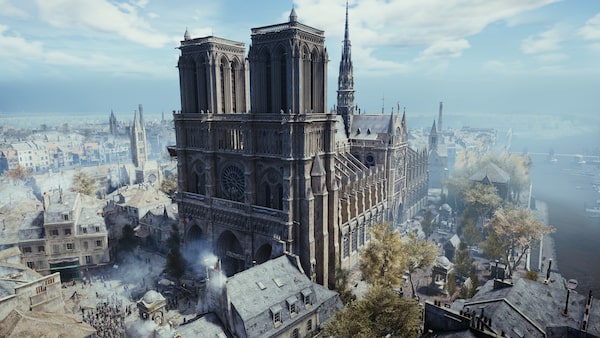
A 3D model of Notre-Dame Cathedral in Paris for the video game Assassin's Creed Unity is shown in a handout photo.�/The Canadian Press
Robert Bork, a world expert in the precision measurement and layout of Notre-Dame Cathedral, is running through a virtual version of the 12th-century Gothic church using Assassin’s Creed Unity, a video game designed in a Montreal studio.
Prof. Bork, an architectural historian, has heard the theory circulating in recent days that the video game designed by Ubisoft might assist in reconstructing the fire-damaged cathedral. He wants to see for himself. Prof. Bork, who has done his own Notre-Dame recreations using laser measurements gathered from a billion data points, fires up a demonstration video and shares observations over the telephone.
Ubisoft’s work strikes him on one level. “Cool. This is impressive. All they had was Pong when I was a kid,” the University of Iowa professor says. His 2014 paper The Chevet Plan at Notre-Dame in Paris: A Geometrical Analysis broke down to within five millimetres the layout of the entire eastern wing of the cathedral. The paper was coincidentally published about the same time the video game was released.
In the first seven seconds of his virtual Assassin’s tour, the initial flaws appear. “Oh, I see their Notre-Dame that is supposed to be medieval has added elements from the 19th century. And they’ve tweaked their [nearby] Sainte-Chapelle back into something more medieval. Things are fudged. It’s kind of hilarious.

Art historian Andrew Tallon used laser scanners to map Notre-Dame de Paris starting in 2010.ANDREW TALLON/AFP/Getty Images
“What they did is good for what it is, but it’s not designed for this process.”
Ubisoft, an anchor of Montreal’s video-game industry with headquarters in Paris, announced Monday it would assist in the Notre-Dame reconstruction with a donation of €500,000 ($754,000) and it would make its five-year-old video game free to download for a week.
“We hope, with this small gesture, we can provide everyone an opportunity to appreciate our virtual homage to this monumental piece of architecture,” the company said in a statement.
Notre-Dame is one of the world’s most documented and examined buildings. Ubisoft officials, who did not want to be interviewed for this story, have previously described how its designers and historians pored over documentation to create the game.
Lead art designer Caroline Miousse did not set foot in the cathedral until her work was done. She and other Ubisoft game makers told The Verge in 2014 that the artistic liberties spotted by Prof. Bork were added to make the game more playable and the view more familiar.

After the Notre-Dame de Paris fire April 15, Tallon's work mapping the building's interior was cited as a potential resource for planned reconstruction.ANDREW TALLON/AFP/Getty Images
Notre-Dame after the fire: What we know so far
Sixty-six minutes: The frantic race to save Notre-Dame
France mulls over rebuild options for iconic Notre-Dame spire
Modern digital technology is still likely to play a role in the cathedral’s reconstruction.
Andrew Tallon, an engineer, architecture historian and colleague of Prof. Bork, began making laser measurements of Notre-Dame in 2010. He documented every surface and interior feature of the church, inch-by-inch – work he described as an obsession.
He discovered the western façade of the cathedral had shifted, and that the “Gallery of Kings” – a series of three statues – is leaning 30 centimetres out of plumb. He discovered new details about construction techniques and craftsmanship.
“When you work on medieval buildings, it’s difficult to have the impression you can say anything new,” Prof. Tallon, who died of brain cancer last fall, told National Geographic in 2015. “So much ink has been spilled over that building. So much of it is completely wrong.”
Prof. Tallon and Columbia art-history professor Stephen Murray created a site called Gothic France where some of their data collected from dozens of sites is shared publicly.
“They were definitely on the cutting edge of applying laser scanning technology to Gothic architecture,” Prof. Bork says.
Recreating the cathedral will be a long and painstaking process but Notre-Dame has several advantages many recovery efforts lack, Prof. Bork says.
“They will have a combination of data, including this laser data, more detailed drawings and photographs. Then it’s just a matter of craftsmanship and money,” he says. “Notre-Dame will not be wanting for attention or documentation.”
 Les Perreaux
Les Perreaux